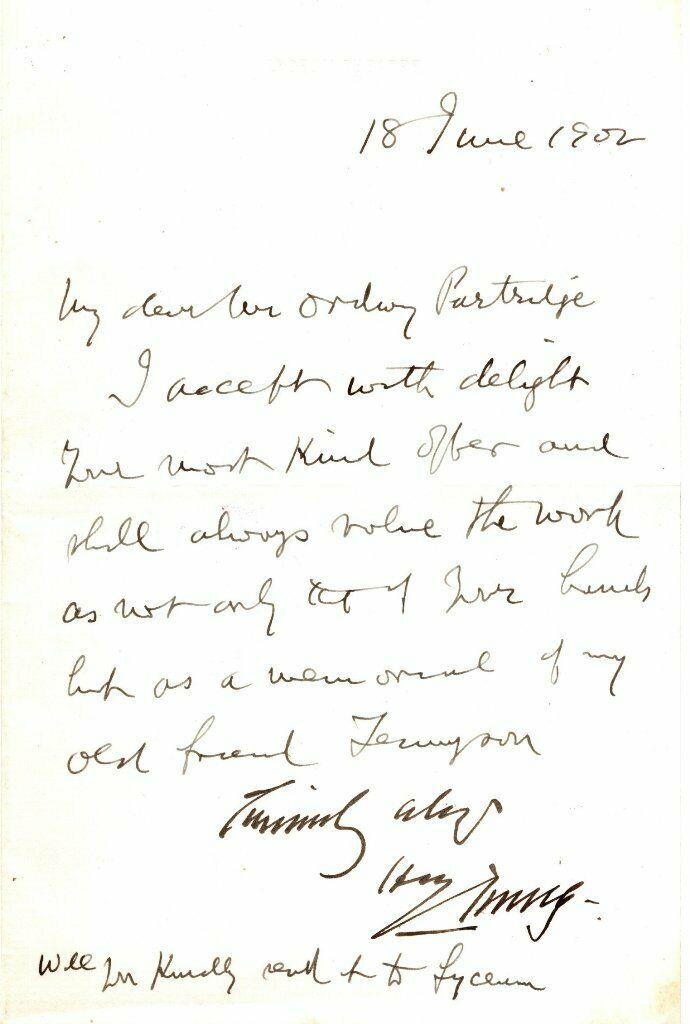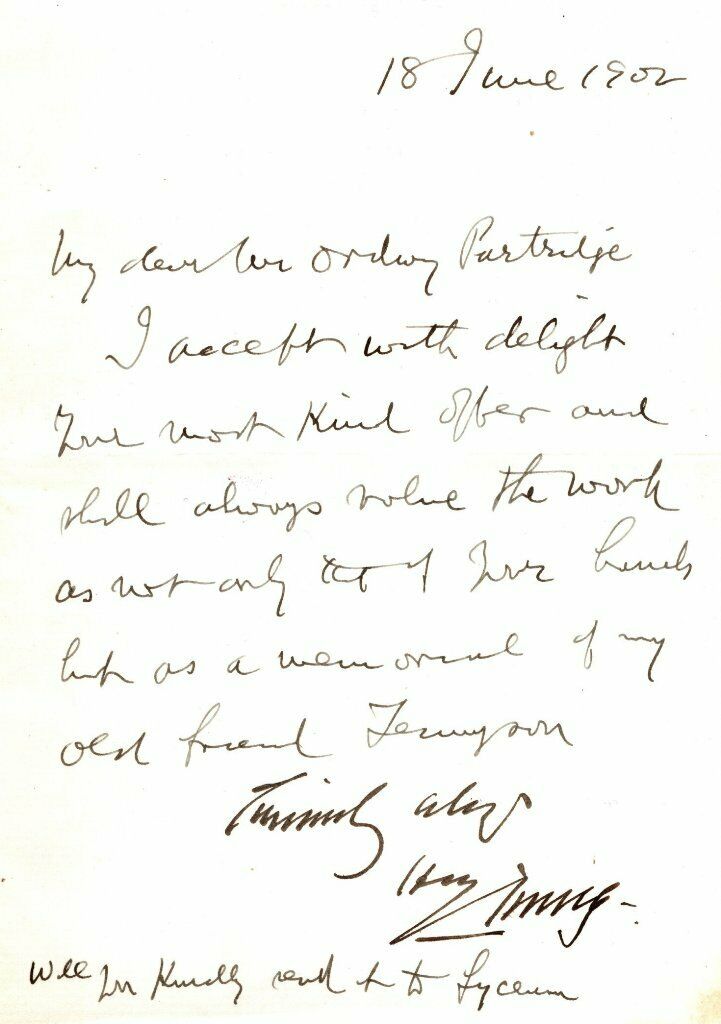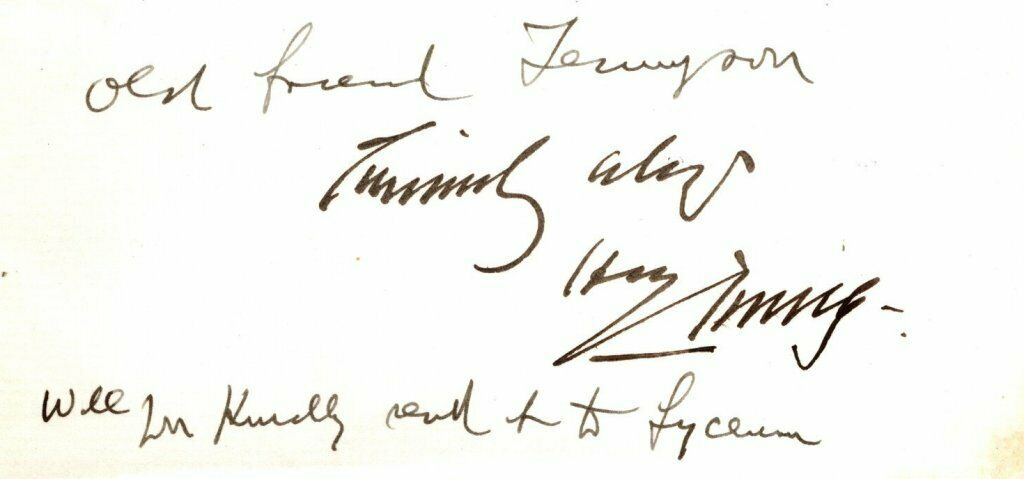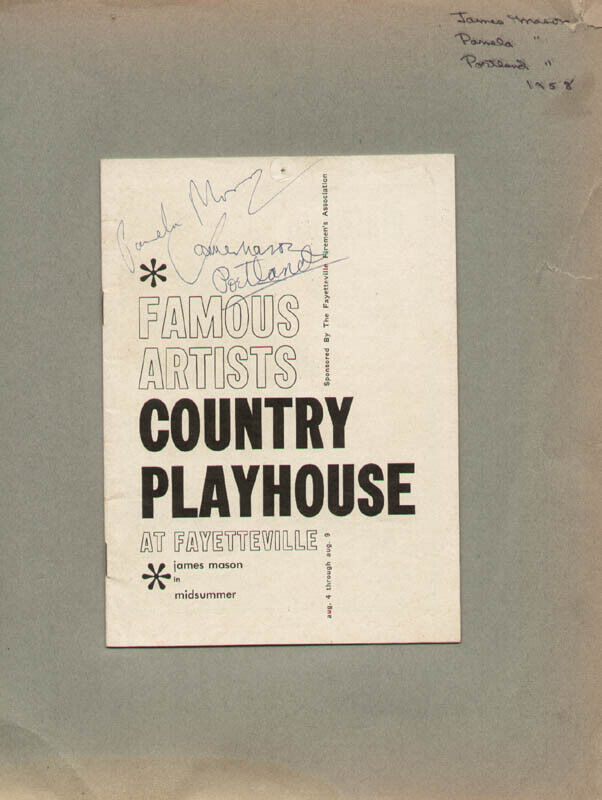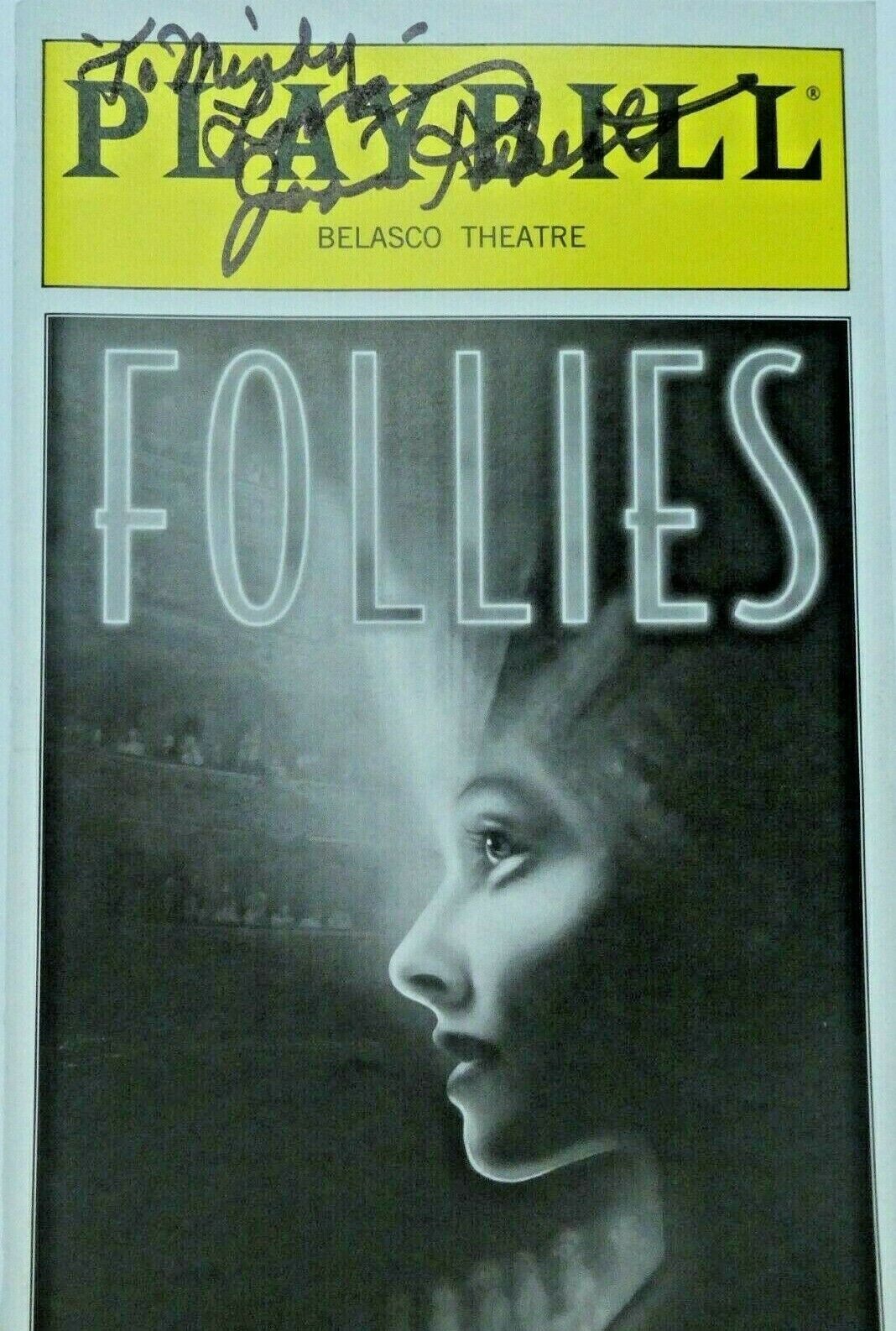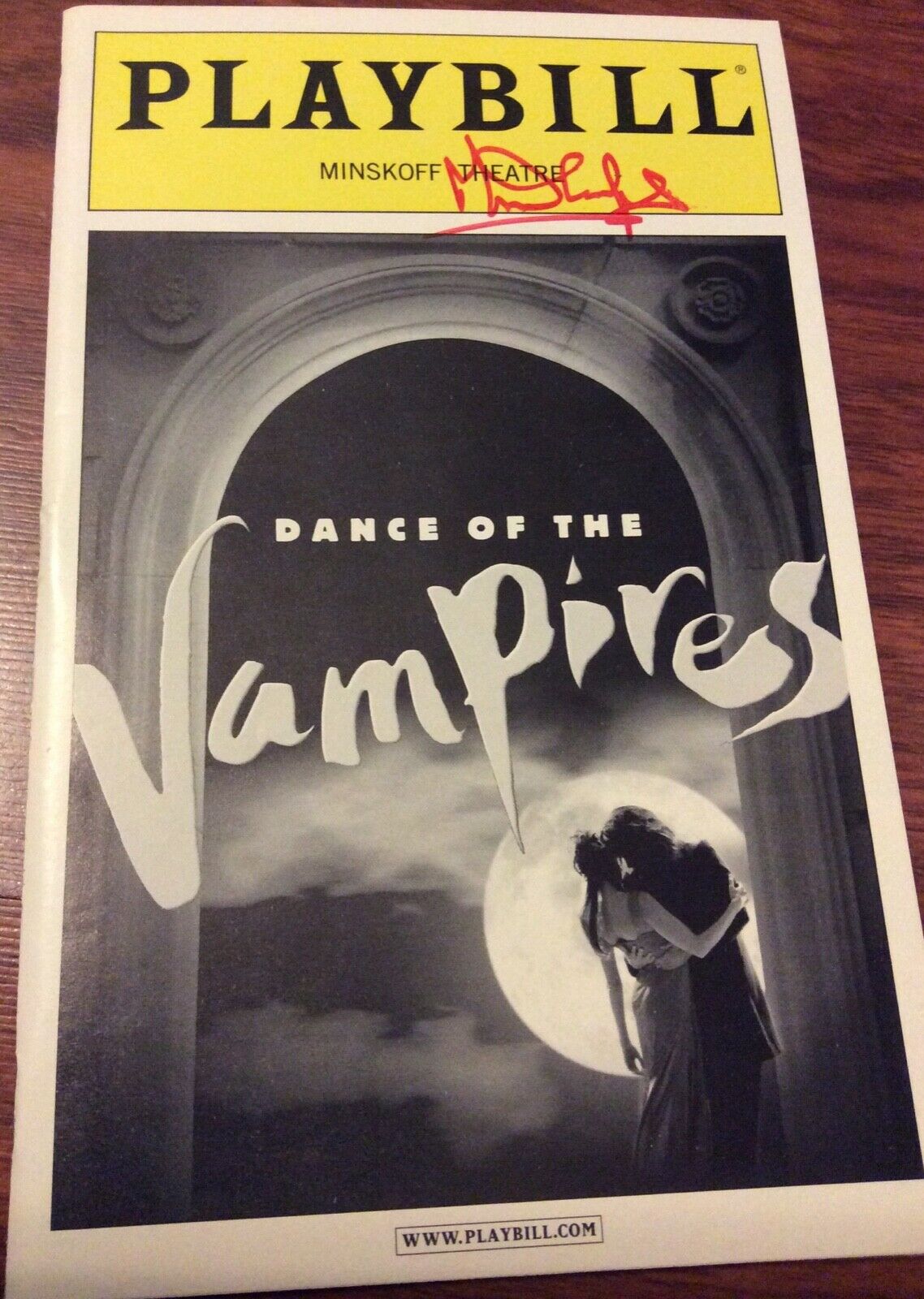-40%
*DRACULA: BRAM STOKER RARE 1902 HAND WRITTEN LETTER TO FAMOUS AMERICAN SCULPTOR*
$ 200.63
- Description
- Size Guide
Description
A rare original boldly autographed 1902 letter from Henry Irving, the greatest British actor of his generation and the first actor to be knighted, written in the hand of Irving's Acting Manager, Bram Stoker, to the noted American sculptor William Ordway Partridge. Future Dracula author Bram Stoker was Irving's Acting Manager, and Dracula was based on Henry Irving. William Ordway Partridge was a friend of Irving, Stoker, and Edwin Booth. Dimensions eight by five inches. Light wear otherwise good. See Bram Stoker, Henry Irving, and William Ordway Partridge's extraordinary biographies below.Shipping discounts for multiple purchases. Inquiries always welcome. Please visit my other eBay items for more early theatre, opera, film and historical autographs, photographs and programs and great actor and actress cabinet photos and CDV's.
From Wikipedia:
Abraham
"
Bram
"
Stoker
(8 November 1847 – 20 April 1912) was an Irish author, best known today for his 1897
Gothic
horror novel
Dracula
. During his lifetime, he was better known as the personal assistant of actor Sir
Henry Irving
and business manager of the
Lyceum Theatre
, which Irving owned.
Stoker was born on 8 November 1847 at 15
Marino Crescent
,
Clontarf
, on the northside of
Dublin
, Ireland.
[1]
His parents were Abraham Stoker (1799–1876) from Dublin and Charlotte Mathilda Blake Thornley (1818–1901), who was raised in
County Sligo
.
[2]
Stoker was the third of seven children, the eldest of whom was
Sir Thornley Stoker
, 1st
Bt.
[3]
Abraham and Charlotte were members of the
Church of Ireland Parish of Clontarf
and attended the parish church with their children, who were baptised there,
[4]
and Abraham was a senior civil servant.
Stoker was bedridden with an unknown illness until he started school at the age of seven, when he made a complete recovery. Of this time, Stoker wrote, "I was naturally thoughtful, and the leisure of long illness gave opportunity for many thoughts which were fruitful according to their kind in later years." He was educated in a private school run by the Rev. William Woods.
[5]
After his recovery, he grew up without further serious illnesses, even excelling as an athlete at
Trinity College, Dublin
, which he attended from 1864 to 1870. He graduated with a BA in 1870, and pursued his MA in 1875. Though he later in life recalled graduating "with honours in mathematics", this appears to have been a mistake.
[6]
He was named University Athlete, participating in multiple sports, including playing rugby for
Dublin University
. He was auditor of the
College Historical Society
(
the Hist
) and president of the
University Philosophical Society
(he remains the only student in Trinity's history to hold both positions), where his first paper was on
Sensationalism in Fiction and Society
.
Early career
Stoker became interested in the theatre while a student through his friend Dr. Maunsell. While working for the
Irish Civil Service
, he became the theatre critic for the
Dublin Evening Mail
,
[7]
which was co-owned by
Sheridan Le Fanu
, an author of Gothic tales. Theatre critics were held in low esteem, but he attracted notice by the quality of his reviews. In December 1876, he gave a favourable review of Henry Irving's
Hamlet
at the
Theatre Royal
in Dublin. Irving invited Stoker for dinner at the
Shelbourne Hotel
where he was staying, and they became friends. Stoker also wrote stories, and "Crystal Cup" was published by the
London Society
in 1872, followed by "The Chain of Destiny" in four parts in
The Shamrock
. In 1876, while a
civil servant
in Dublin, Stoker wrote the non-fiction book
The Duties of Clerks of Petty Sessions in Ireland
(published 1879) which remained a standard work.
[5]
Furthermore, he possessed an interest in art, and was a founder of the Dublin Sketching Club in 1879.
Lyceum Theatre
Bram Stoker's former home,
Kildare Street
, Dublin
In 1878, Stoker married
Florence Balcombe
, daughter of
Lieutenant-Colonel
James Balcombe of 1 Marino Crescent. She was a celebrated beauty whose former suitor had been
Oscar Wilde
.
[8]
Stoker had known Wilde from his student days, having proposed him for membership of the university's Philosophical Society while he was president. Wilde was upset at Florence's decision, but Stoker later resumed the acquaintanceship, and after Wilde's fall visited him on the Continent.
[9]
The first edition cover of
Dracula
The Stokers moved to London, where Stoker became acting manager and then business manager of
Irving
's
Lyceum Theatre, London
, a post he held for 27 years. On 31 December 1879, Bram and Florence's only child was born, a son whom they christened Irving Noel Thornley Stoker. The collaboration with Henry Irving was important for Stoker and through him he became involved in London's
high society
, where he met
James Abbott McNeill Whistler
and
Sir Arthur Conan Doyle
(to whom he was distantly related). Working for Irving, the most famous actor of his time, and managing one of the most successful theatres in London made Stoker a notable if busy man. He was dedicated to Irving and his memoirs show he idolised him. In London, Stoker also met
Hall Caine
, who became one of his closest friends – he dedicated
Dracula
to him.
In the course of Irving's tours, Stoker travelled the world, although he never visited
Eastern Europe
, a setting for his most famous novel. Stoker enjoyed the United States, where Irving was popular. With Irving he was invited twice to the
White House
, and knew
William McKinley
and
Theodore Roosevelt
. Stoker set two of his novels in America, and used Americans as characters, the most notable being
Quincey Morris
. He also met one of his literary idols,
Walt Whitman
.
Bram Stoker in Cruden Bay
Slains Castle
,
Cruden Bay
. The early chapters of
Dracula
were written in Cruden Bay, and Slains Castle possibly provided visual inspiration for Bram Stoker during the writing phase.
Stoker was a regular visitor to
Cruden Bay
in Scotland between 1893 and 1910. His month-long holidays to the Aberdeenshire coastal village provided a large portion of available time for writing his books. Two novels were set in Cruden Bay:
The Watter's Mou'
(1895) and
The Mystery of the Sea
(1902). He started writing
Dracula
here in 1895 while in residence at the Kilmarnock Arms Hotel. The guest book with his signatures from 1894 and 1895 still survives. The nearby Slains Castle (also known as
New Slains Castle
) is linked with Bram Stoker and plausibly provided the visual palette for the descriptions of Castle Dracula during the writing phase. A distinctive room in Slains Castle, the octagonal hall, matches the description of the octagonal room in Castle Dracula.
[10]
Writings
Bram Stoker Commemorative Plaque,
Whitby
, England
Stoker visited the English coastal town of
Whitby
in 1890, and that visit was said to be part of the inspiration for
Dracula
. He began writing novels while working as manager for Irving and secretary and director of London's Lyceum Theatre, beginning with
The Snake's Pass
in 1890 and
Dracula
in 1897. During this period, Stoker was part of the literary staff of
The Daily Telegraph
in London, and he wrote other fiction, including the horror novels
The Lady of the Shroud
(1909) and
The Lair of the White Worm
(1911).
[11]
He published his
Personal Reminiscences of Henry Irving
in 1906, after Irving's death, which proved successful,
[5]
and managed productions at the
Prince of Wales Theatre
.
Before writing
Dracula
, Stoker met
Ármin Vámbéry
, a Hungarian-Jewish writer and traveller (born in Szent-György,
Kingdom of Hungary
now
Svätý Jur
,
Slovakia
). Dracula likely emerged from Vámbéry's dark stories of the
Carpathian mountains
.
[12]
Stoker then spent several years researching Central and East European folklore and mythological stories of
vampires
.
The 1972 book
In Search of Dracula
by
Radu Florescu
and
Raymond McNally
claimed that the Count in Stoker's novel was based on
Vlad III Dracula
.
[13]
At most however, Stoker borrowed only the name and "scraps of miscellaneous information" about Romanian history, according to one expert,
Elizabeth Miller
; further, there are no comments about Vlad III in the author's working notes.
[14]
[15]
[16]
Dracula
is an
epistolary novel
, written as a collection of realistic but completely fictional diary entries, telegrams, letters, ship's logs, and newspaper clippings, all of which added a level of detailed realism to the story, a skill which Stoker had developed as a newspaper writer. At the time of its publication,
Dracula
was considered a "straightforward horror novel" based on imaginary creations of
supernatural
life.
[11]
"It gave form to a universal fantasy ... and became a part of popular culture."
[11]
Stoker was a deeply private man, but his almost sexless marriage, intense adoration of
Walt Whitman
,
Henry Irving
and
Hall Caine
, and shared interests with
Oscar Wilde
, as well as the homoerotic aspects of
Dracula
have led to scholarly speculation that he was a repressed homosexual who used his fiction as an outlet for his sexual frustrations.
[17]
In 1912, he demanded imprisonment of all homosexual authors in Britain: it has been suggested that this was due to self-loathing and to disguise his own vulnerability.
[18]
Possibly fearful, and inspired by the monstrous image and threat of otherness that the press coverage of his friend Oscar's trials generated, Stoker began writing
Dracula
only weeks after Wilde's conviction.
[18]
[19]
According to the
Encyclopedia of World Biography
, Stoker's stories are today included in the categories of "horror fiction", "romanticized Gothic" stories, and "melodrama".
[11]
They are classified alongside other "works of popular fiction" such as
Mary Shelley
's
Frankenstein
,
[20]
:394
which also used the "myth-making" and story-telling method of having
multiple narrators
telling the same tale from different perspectives. According to historian Jules Zanger, this leads the reader to the assumption that "they can't all be lying".
[21]
The original 541-page typescript of
Dracula
was believed to have been lost until it was found in a barn in northwestern Pennsylvania in the early 1980s.
[22]
It consisted of typed sheets with many emendations and handwritten on the title page was "THE UN-DEAD." The author's name was shown at the bottom as Bram Stoker. Author Robert Latham remarked: "the most famous horror novel ever published, its title changed at the last minute."
[20]
The typescript was purchased by
Microsoft
co-founder
Paul Allen
.
Stoker's inspirations for the story, in addition to Whitby, may have included a visit to
Slains Castle
in
Aberdeenshire
, a visit to the crypts of
St. Michan's Church
in Dublin, and the novella
Carmilla
by
Sheridan Le Fanu
.
[23]
Stoker's original research notes for the novel are kept by the
Rosenbach Museum and Library
in
Philadelphia
. A facsimile edition of the notes was created by
Elizabeth Miller
and
Robert Eighteen-Bisang
in 1998.
Stoker at The London Library
Stoker was a member of The
London Library
and it is here that he conducted much of the research for
Dracula.
[24]
In 2018, the Library discovered some of the books that Stoker used for his research, complete with notes and marginalia.
[25]
Death
Urn which contains Stoker's ashes in
Golders Green Crematorium
After suffering a number of strokes, Stoker died at No. 26
St George's Square
, London on 20 April 1912.
[26]
Some biographers attribute the cause of death to overwork,
[27]
others to
tertiary syphilis
.
[28]
Bram Stoker's
death certificate
named the cause of death as "
Locomotor ataxia
6 months", presumed to be a reference to syphilis.
[29]
[30]
He was
cremated
, and his ashes were placed in a display urn at
Golders Green Crematorium
in north London. The ashes of Irving Noel Stoker, the author's son, were added to his father's urn following his death in 1961. The original plan had been to keep his parents' ashes together, but after Florence Stoker's death, her ashes were scattered at the Gardens of Rest.
Beliefs and philosophy
Stoker was raised a Protestant in the
Church of Ireland
. He was a strong supporter of the
Liberal Party
and took a keen interest in Irish affairs.
[5]
As a "philosophical home ruler", he supported
Home Rule
for Ireland brought about by peaceful means. He remained an ardent monarchist who believed that Ireland should remain within the British Empire, an entity that he saw as a force for good. He was an admirer of Prime Minister
William Ewart Gladstone
, whom he knew personally, and supported his plans for Ireland.
[31]
Stoker believed in progress and took a keen interest in
science
and science-based
medicine
. Some of Stoker's novels represent early examples of
science fiction
, such as
The Lady of the Shroud
(1909). He had a writer's interest in the occult, notably
mesmerism
, but despised fraud and believed in the superiority of the
scientific method
over superstition. Stoker counted among his friends J.W. Brodie-Innis, a member of the
Hermetic Order of the Golden Dawn
, and hired member
Pamela Colman Smith
as an artist for the Lyceum Theatre, but no evidence suggests that Stoker ever joined the Order himself.
[32]
[33]
[34]
Although Irving was an active
Freemason
, no evidence has been found of Stoker taking part in Masonic activities in London.
[35]
The
Grand Lodge of Ireland
also has no record of his membership.
[36]
Posthumous
The short story collection
Dracula's Guest and Other Weird Stories
was published in 1914 by Stoker's widow,
Florence Stoker
, who was also his
literary executrix
. The first film adaptation of
Dracula
was
F. W. Murnau
's
Nosferatu
, released in 1922, with
Max Schreck
starring as Count Orlok. Florence Stoker eventually sued the filmmakers, and was represented by the attorneys of the British Incorporated Society of Authors. Her chief legal complaint was that she had neither been asked for permission for the adaptation nor paid any royalty. The case dragged on for some years, with Mrs. Stoker demanding the destruction of the negative and all prints of the film. The suit was finally resolved in the widow's favour in July 1925. A single print of the film survived, however, and it has become well known. The first authorised film version of
Dracula
did not come about until almost a decade later when
Universal Studios
released
Tod Browning
's
Dracula
starring
Bela Lugosi
.
Dacre Stoker
Canadian
writer
Dacre Stoker
, a great-grandnephew of Bram Stoker, decided to write "a sequel that bore the Stoker name" to "reestablish creative control over" the original novel, with encouragement from screenwriter Ian Holt, because of the Stokers' frustrating history with
Dracula's
copyright. In 2009,
Dracula: The Un-Dead
was released, written by Dacre Stoker and Ian Holt. Both writers "based [their work] on Bram Stoker's own handwritten notes for characters and plot threads excised from the original edition" along with their own research for the sequel. This also marked Dacre Stoker's writing debut.
[37]
[38]
In spring 2012, Dacre Stoker (in collaboration with Elizabeth Miller) presented the "lost" Dublin Journal written by Bram Stoker, which had been kept by his great-grandson Noel Dobbs. Stoker's diary entries shed a light on the issues that concerned him before his London years. A remark about a boy who caught flies in a bottle might be a clue for the later development of the Renfield character in
Dracula
.
[39]
Commemorations
On 8 November 2012, Stoker was honoured with a
Google Doodle
on Google's homepage commemorating the 165th anniversary of his birth.
[40]
[41]
An annual festival takes place in Dublin, the birthplace of Bram Stoker, in honour of his literary achievements. The 2014 Bram Stoker Festival encompassed literary, film, family, street, and outdoor events, and ran from 24–27 October in Dublin.
[42]
[43]
The festival is supported by the Bram Stoker Estate
[44]
and funded by
Dublin City Council
and
Fáilte Ireland
.
Sir Henry Irving
(6 February 1838 – 13 October 1905), born
John Henry Brodribb
, sometimes known as
J. H. Irving
, was an English stage actor in the
Victorian era
, known as an
actor-manager
because he took complete responsibility (supervision of sets, lighting, direction, casting, as well as playing the leading roles) for season after season at the
Lyceum Theatre
, establishing himself and his company as representative of English classical theatre. In 1895 he became the first actor to be awarded a
knighthood
, indicating full acceptance into the higher circles of British society.
Irving is widely acknowledged to be one of the inspirations for
Count Dracula
, the title character of the 1897 novel
Dracula
whose author,
Bram Stoker
, was business manager of the theatre.
Irving was born to a
working-class
family in
Keinton Mandeville
in the county of
Somerset
.
[1]
W.H. Davies
, the celebrated poet, was a cousin. Irving spent his childhood living with his aunt, Mrs Penberthy, at
Halsetown
in
Cornwall
. He competed in a recitation contest at a local
Methodist
chapel where he was bested by
William Curnow
, later the editor of
The Sydney Morning Herald
.
[2]
He attended City Commercial School for two years before going to work in the office of a law firm at age 13. When he saw
Samuel Phelps
play
Hamlet
soon after this, he sought lessons, letters of introduction, and work in a theatre in
Sunderland
in 1856, labouring against great odds until his 1871 success in
The Bells
in
London
set him apart from all the rest.
He married Florence O'Callaghan on 15 July 1869 at St. Marylebone, London, but his personal life took second place to his professional life. On opening night of
The Bells
, 25 November 1871, Florence, who was pregnant with their second child, criticised his profession: "Are you going on making a fool of yourself like this all your life?" Irving exited their carriage at
Hyde Park Corner
, walked off into the night, and chose never to see her again. He maintained a discreet distance from his children as well, but became closer to them as they grew older. Florence Irving never divorced Irving, and once he had been knighted she styled herself "Lady Irving"; Irving never remarried.
[3]
Sir Henry Irving, as
Hamlet
, in an 1893 illustration from
The Idler
magazine
His elder son,
Harry Brodribb Irving
(1870–1919), usually known as "H B Irving", became a famous actor and later a theatre manager. His younger son,
Laurence Irving
(1871–1914), became a
dramatist
and later drowned, with his wife, in the sinking of the
Empress of Ireland
. H B married
Dorothea Baird
and they had a son,
Laurence Irving
(1897–1988), who became a well-known
Hollywood
art director and his grandfather's biographer.
In November 1882 Irving became a
Freemason
, being initiated into the prestigious Jerusalem Lodge No 197 in London.
[4]
In 1887 he became a founder member and first Treasurer of the Savage Club Lodge No 2190,
[5]
a Lodge associated with London's
Savage Club
.
He eventually took over the management of the Lyceum Theatre and brought actress
Ellen Terry
into partnership with him as
Ophelia
to his Hamlet,
Lady Macbeth
to his
Macbeth
,
Portia
to his
Shylock
, Beatrice to his Benedick, etc. Before joining the Lyceum, Terry had fled her first marriage and conceived two out-of-wedlock children with architect-designer
Edward William Godwin
, but regardless of how much and how often her behavior defied the strict morality expected by her Victorian audiences, she somehow remained popular. It could be said that Irving found his family in his professional company, which included his ardent supporter and manager Bram Stoker and Terry's two illegitimate children, Teddy and Edy.
Whether Irving's long, spectacularly successful relationship with leading lady
Ellen Terry
was romantic as well as professional has been the subject of much historical speculation. Most of their correspondence was lost or burned by her descendants.
[6]
According to
Michael Holroyd
's book about Irving and Terry,
A Strange Eventful History
:
Years later, when Irving was dead, Marguerite Steen asked Ellen whether she really had been Irving's lover, and she promptly answered: 'Of course I was. We were terribly in love for a while.' But at earlier periods in her life, when there were more people around to be offended, she said contradictory things.
Terry's son Teddy, later known as
Edward Gordon Craig
, spent much of his childhood (from 1879, when he was 8, until 1897) indulged by Irving backstage at the Lyceum. Craig, who came to be regarded as something of a visionary for the theatre of the future, wrote an especially vivid, book-length tribute to Irving. ("Let me state at once, in clearest unmistakable terms, that I have never known of, or seen, or heard, a greater actor than was Irving.")
George Bernard Shaw
, at the time a theatre critic who was jealous of Irving's connection to Ellen Terry (whom Shaw himself wanted in his own plays), conceded Irving's genius after Irving died.
William Ordway Partridge
(April 11, 1861 – May 22, 1930) was an American
sculptor
whose public commissions can be found in New York City and other locations.
William Partridge was born in Paris to American parents descended from the Pilgrims in Massachusetts; his father was a representative of
A.T. Stewart
. At the end of the reign of
Napoleon III
, Partridge travelled to America to attend
Adelphi Academy
in
Brooklyn
and
Columbia University
(graduated 1883) in New York. After a year of experimentation in theatre, he went abroad to study sculpture. During a brief stint in the Paris studio of
William-Adolphe Bouguereau
, he formed a close friendship with the neo-Gothic architect
Ralph Adams Cram
on his 1887 trip.
[1]
He knew the young
Bernard Berenson
in
Florence
, where he studied in the studio of Galli, and
Rome
, in the studio of Pio Welonski (1883–1885).
[2]
His published work includes articles on
aesthetics
and several art history books including
Art For America
(1894),
The Song Life of a Sculptor
(1894), and
The Technique of Sculpture
(1895). He also wrote poems and published the verse novels
Angel of Clay
(1900) and
The Czar's Gift
(1906).
[3]
Aside from his public commissions, his work consisted mostly of portrait busts. In 1893 eleven of his works were displayed at the
World's Columbian Exposition
, Chicago, according to the official catalog of the Fine Arts Building at the fair, where he exhibited sculptures of
Alexander Hamilton
and
William Shakespeare
[4]
as well as portraits. In this same catalog Partridge was listed as living in
Milton, Massachusetts
. He maintained homes and studios in both Milton and New York. Among his studio assistants on West 38th Street in New York was
Lee Lawrie
.
Partridge went on to lecture at
Stanford University
in California, and assumed a
professorship
at Columbian University, now
George Washington University
, in Washington, D.C.
His life-size statue of the
Native American
princess
Pocahontas
was unveiled in
Jamestown, Virginia
in 1922.
Queen Elizabeth II
viewed this statue in 1957 and again on May 4, 2007, while visiting Jamestown on the 400th anniversary of the founding of the first successful English colonial settlement in America. On October 5, 1958, a replica of the
Pocahontas
statue by Partridge was dedicated as a memorial to the princess at the location of her burial in 1617 at
St. George's Church
in
Gravesend
, England. The Governor of Virginia presented the replica statue as a gift to the British people.
Partridge died in
Manhattan
, New York on May 22, 1930.
Selected works
[
edit
]
Pocahontas
, erected in
Jamestown, Virginia
, 1922
A considerable amount of Partridge's
statuary
remains on public display in New York City and other locations:
Samuel J. Tilden
, on Riverside Drive at 113th Street.
Statue of Thomas Jefferson
(1914), in front of Journalism Hall at
Columbia University
.
Thomas Jefferson
, New-York Historical Society, 1901.
[5]
Alexander Hamilton
,
Hamilton Grange
, New York, (1892.
[6]
) This standing figure was commissioned by the Hamilton Club of Brooklyn and having been exhibited at the World's Columbian Exposition, stood in front of the Club's premises in Brooklyn Heights, 1893–1936, when it was removed to its present location.
[7]
A
1908 replica
stands in front of Hamilton Hall, Columbia University.
[8]
Edward Everett Hale
, bust, Union League Club of Chicago. (
Appleton's Cyclopaedia
)
A bust of
Dean
John Howard Van Amringe
at Columbia University.
Nathan Hale
[9]
The marble memorial plaque showing the likeness of
James Smithson
in the crypt room where Smithson's tomb is located, inside The Castle Building of the
Smithsonian Institution
, Washington, D.C., 1900. The original of this work is in
Genoa, Italy
, where Smithson died.
[10]
The Resurrection
, marble bas-relief for the
National Cathedral
, Washington, D.C., 1902.
The
marble
Pietà
at
St. Patrick's Cathedral
.
The
equestrian
statue of General
Ulysses S. Grant
, commissioned by the Union Club of Brooklyn and unveiled April 27, 1896, in Grant Square, at Bedford Avenue and Dean Street, Crown Heights,
Brooklyn
.
The bust of
Theodore Roosevelt
at the Republican Club.
The marble
Peace Head
at the
Metropolitan Museum of Art
, New York.
Anne's Tablet
, memorial to
Constance Fenimore Woolson
,
Mackinac Island
, Michigan
Pietà
,
St. Patrick's Cathedral
, New York, transept.
The
Samuel H. Kauffman Memorial
ca. 1921, Rock Creek Cemetery, Washington, D.C. A seated bronze figure on a marble exedra with bronze bas-reliefs of the
Seven Ages of Man
after Shakespeare.
[11]
The
Joseph Pulitzer
Memorial
(1913) in
Woodlawn Cemetery
, The Bronx.
[12]
Seated mourning figure.
Memory
1914. Memorial Art Gallery, Rochester, New York.
